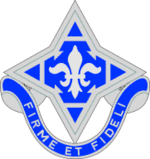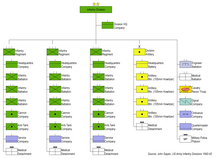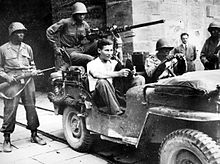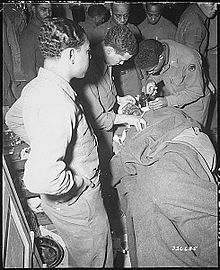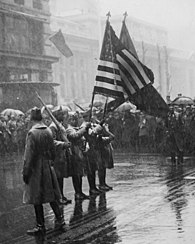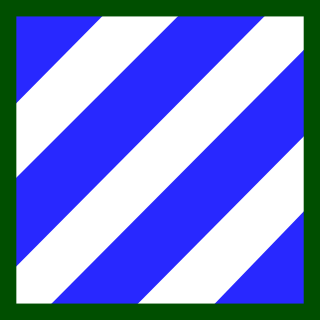
The 3rd Infantry Division (3ID) is a combined arms division of the United States Army based at Fort Stewart, Georgia. It is a subordinate unit of the XVIII Airborne Corps under U.S. Army Forces Command. Its current organization includes a division headquarters and headquarters battalion, two armored brigade combat teams, one aviation brigade, a division artillery, a sustainment brigade and a combat sustainment support battalion along with a maneuver enhancement brigade. The division has a distinguished history, having seen active service in World War I, World War II, the Korean War, and the Global War on Terror. The Medal of Honor has been awarded to 61 members of the 3rd Infantry Division, making the division the most honored in the Army.

The 36th Infantry Division ("Arrowhead") also known as the "Panther Division", the "Lone Star Division", "The Texas Army", and the "T-patchers", is an infantry division of the U.S. Army and part of the Texas Army National Guard. The 36th Infantry Division was organized during World War I (1914–1918) from units of the Texas National Guard and of the Oklahoma National Guard. As an all-Texas unit, the Arrowhead Division was called to service for World War II (1937–1945) on 25 November 1940, was deployed to the European Theater of Operations in April 1943, and returned to the Texas Army National Guard in December 1945.

The 1st Infantry Division (1ID) is a combined arms division of the United States Army, and is the oldest continuously serving division in the Regular Army. It has seen continuous service since its organization in 1917 during World War I. It was officially nicknamed "The Big Red One" after its shoulder patch and is also nicknamed "The Fighting First." The division has also received troop monikers of "The Big Dead One" and "The Bloody First" as puns on the respective officially sanctioned nicknames. It is currently based at Fort Riley, Kansas.

The 65th Infantry Division—nicknamed the "Battle-Axe Division"—was an infantry division of the United States Army that served in World War II. Its shoulder patch is a white halberd on a blue shield.

The 80th Training Command is a formation of the United States Army Reserve.

The 93rd Infantry Division was a "colored" segregated unit of the United States Army in World War I and World War II. However, in World War I only its four infantry regiments, two brigade headquarters, and a provisional division headquarters were organized, and the divisional and brigade headquarters were demobilized in May 1918. Its regiments fought primarily under French command in that war and saw action during the Second Battle of the Marne. They acquired the nickname Blue Helmets from the French, as these units were issued horizon blue French Adrian helmets. Consequently, its shoulder patch became a blue French helmet, to commemorate its service with the French Army during the German spring offensive.

The 34th Infantry Division is an infantry division of the United States Army, part of the National Guard, that participated in World War I, World War II and multiple current conflicts. It was the first American division deployed to Europe in World War II, where it fought with great distinction in the Italian Campaign.

The 442nd Infantry Regiment was an infantry regiment of the United States Army. The regiment including the 100th Infantry Battalion is best known as the most decorated in U.S. military history, and as a fighting unit composed almost entirely of second-generation American soldiers of Japanese ancestry (Nisei) who fought in World War II. Beginning in 1944, the regiment fought primarily in the European Theatre, in particular Italy, southern France, and Germany. The 442nd Regimental Combat Team (RCT) was organized on March 23, 1943, in response to the War Department's call for volunteers to form the segregated Japanese American army combat unit. More than 12,000 Nisei volunteers answered the call. Ultimately 2,686 from Hawaii and 1,500 from mainland U.S. internment camps assembled at Camp Shelby, Mississippi in April 1943 for a year of infantry training. Many of the soldiers from the continental U.S. had families in internment camps while they fought abroad. The unit's motto was "Go for Broke".
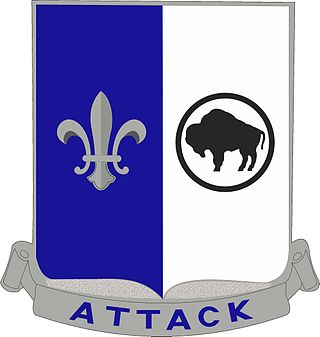
The 371st Infantry Regiment was a segregated African American regiment, nominally a part of the 93rd Division, that served in World War I under French Army command, and also in World War II in the Italian Campaign as part of the 92nd Infantry Division (Colored).

The 100th Infantry Battalion is the only infantry unit in the United States Army Reserve. In World War II, the then-primarily Nisei battalion was composed largely of former members of the Hawaii Army National Guard. The 100th saw heavy combat during World War II, starting in September 1943 and continuing after being attached as a battalion of the Nisei 442nd Regimental Combat Team in June 1944. The unit was unofficially nicknamed the Purple Heart Battalion, with the motto "Remember Pearl Harbor".
The 366th Infantry Regiment was an all Colored (segregated) unit of the United States Army that served in both World War I and World War II. In the latter war, the unit was exceptional for having all negro officers as well as troops. The U.S. military did not desegregate until after World War II. During the war, for most of the segregated units, all field grade and most of the company grade officers were white.

John Robert Fox was a United States Army first lieutenant who was killed in action after calling in artillery fire on the enemy during World War II. In 1997, he was posthumously awarded the Medal of Honor, the nation's highest military decoration for valor, for his actions on December 26, 1944, in the vicinity of Sommocolonia, Italy. It is believed that he called in his own coordinates because he was in an area overrun with German soldiers.
805th Pioneer Infantry was an all-African American infantry regiment of the United States Army during World War I. The 805th contained black soldiers from the state of Mississippi. The regiment landed in France in July 1918 and served in Europe until July 1919; the division saw 39 days of action.

Colonel Virgil Rasmuss Miller was a United States Army officer who served as Regimental Commander of the 442d Regimental Combat Team (RCT), a unit which was composed of "Nisei", during World War II. He led the 442nd in its rescue of the Lost Texas Battalion of the 36th Infantry Division, in the forests of the Vosges Mountains in northeastern France.

The Spring 1945 offensive in Italy, codenamed Operation Grapeshot, was the final Allied attack during the Italian Campaign in the final stages of the Second World War. The attack into the Lombard Plain by the Allied 15th Army Group started on 6 April 1945 and ended on 2 May with the surrender of German forces in Italy.

The 370th Infantry Regiment was the designation for one of the infantry regiments of the 93rd (Provisional) Infantry Division in World War I. Known as the "Black Devils", for their fierce fighting during the First World War and a segregated unit, it was the only United States Army combat unit with African-American officers. In World War II, a regiment known as the 370th Infantry Regiment was part of the segregated 92nd Infantry Division, but did not perpetuate the lineage of the 8th Illinois or World War I 370th, only sharing its numerical designation.

The Battle of Garfagnana, known to the Germans as Operation Winter Storm and nicknamed the "Christmas Offensive", was a successful Axis offensive against American forces on the western sector of the Gothic Line during World War II. It took place in December 1944 in the north Tuscan Apennines, near Massa and Lucca.

Sommocolonia is a hilltop village in Barga, Lucca, Italy. As of 2022, it had a population of 21. The village was heavily damaged during World War II, where it was the site of a battle between the Wehrmacht and the African American 92nd Infantry Division. The village's population has gradually decreased since the 1930s, as most residents left in search of work.

Major General Frederic Ellis Davison was a United States Army officer and the first African American to reach the rank of major general and become a division commander. After serving in World War II, he served as commander of the 199th Light Infantry Brigade during the Vietnam War.
Daniel Mack was a soldier from the 365th Infantry Regiment an all-Black unit that fought with honours in World War I. He was lynched but survived during the Red Summer a period of racial violence in America.

